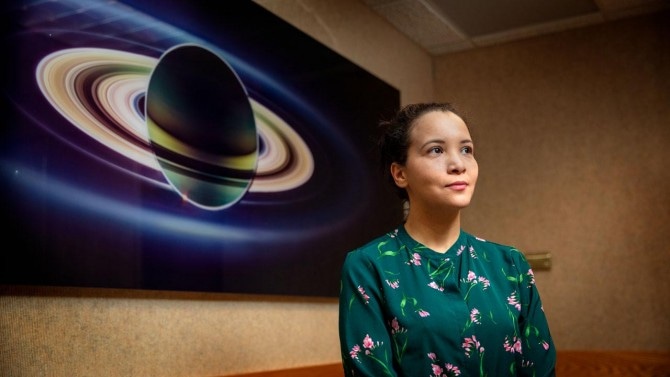Nov 20 2018
Overlook those shepherding moons. According to a new research in Nature Astronomy, gravity and the strange shapes of asteroid Chariklo and dwarf planet Haumea – small objects deep in Earth’s solar system – can be attributed for developing and maintaining their own rings.
 Maryame El Moutamid, part of an international scientific team, has found that gravity – rather than shepherding moons – retains rings around small cosmic bodies. (Image credit: Jason Koski/Cornell Brand Communications)
Maryame El Moutamid, part of an international scientific team, has found that gravity – rather than shepherding moons – retains rings around small cosmic bodies. (Image credit: Jason Koski/Cornell Brand Communications)
“Rings appear around Saturn, Jupiter, Neptune, and Uranus, but scientists found rings around Chariklo and Haumea within the last few years. Chariklo and Haumea were the first small objects known to have rings, and we think that rings throughout the solar system are more common than we thought,” said Maryame El Moutamid, research associate in the Cornell Center for Astrophysics and Planetary Science and an author of the new paper.
In the case of small bodies Chariklo and Haumea, gravity shepherds the rings. The rings are confined by the gravity because of the shape irregularity of their bodies.
Maryame El Moutamid, Research Associate, Cornell Center for Astrophysics and Planetary Science
Up till now, scientific literature largely assumed that the gravitational torques from shepherd moons around planets maintained the rings in shape and prevented them from spreading and vanishing. Instead, this study reveals that a topographic anomaly on the object, such as a mountain, may play a similar gravitational role as a “moon” to keep the rings together.
Besides gravity, rapidly spinning cosmic bodies that form specific resonance also maintain rings from expanding, dissipating, and vanishing.
Chariklo is a small, rocky asteroid between Saturn and Uranus. It is around 188 miles in diameter and requires 63 years to orbit the sun. It is the largest object in an asteroid class called Centaurs, according to NASA.
In the meantime, Haumea, a trans-Neptunian object, about the size of Pluto, resembles a flattened ball with a 385-mile diameter. It can be seen in the Kuiper Belt, a region beyond the orbit of Neptune. Haumea was spotted in December 2004 and requires around 285 years to orbit the Sun.
With Saturn, the rings are shepherded by miniature moons to keep them in position. But for Chariklo, its unusual, rocky shape – which comprises of a large “mountain” – keeps the rings in position just beyond the border of the Roche limit – the closest a small object can approach the larger one it orbits without being ripped apart by tidal force.
“In the case of Chariklo, the irregularities confine the rings. In the case of Haumea, the body’s big flatness does the job,” said El Moutamid, who is also a member of Cornell’s Carl Sagan Institute.
Astronomer Bruno Sicardy of the Observatoire de Paris led the research in a project named Lucky Star. Other authors of the paper, “Ring Dynamics Around Non-axisymmetric Bodies,” are by Stéfan Renner, Françoise Roques and Josselin Desmars, Observatoire de Paris; Rodrigo Leiva, Southwest Research Institute, Boulder, Colorado; and Pablo Santos-Sanz, Instituto de Astrofısica de Andalućıa, Spain. Funding was provided by the European Research Council.